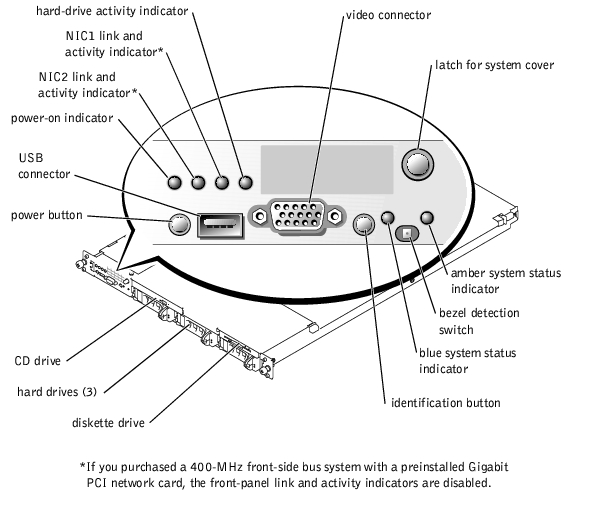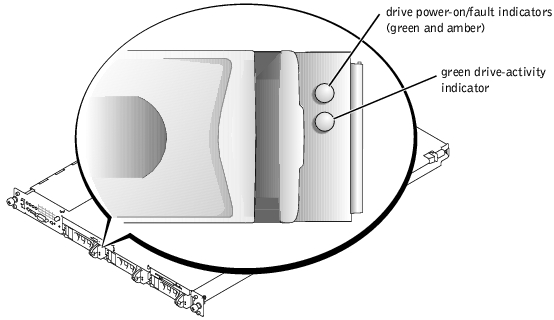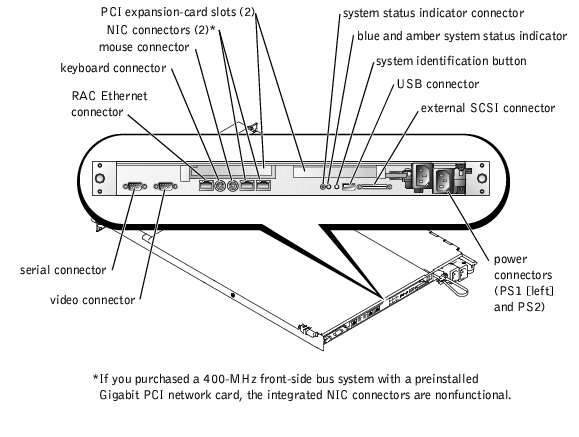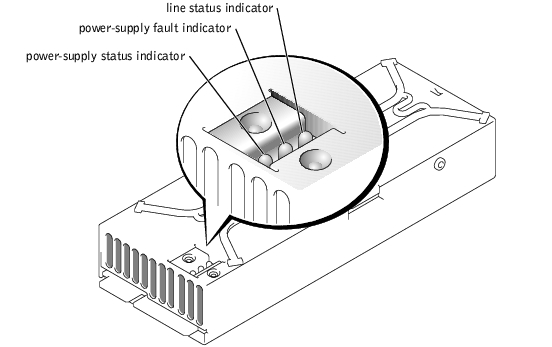|
Message
|
Causes
|
Corrective Actions
|
|---|
Address mark not found
| Faulty diskette/CD drive subsystem or hard-drive subsystem (defective system board). | Replace the system board. See "System Board." |
Amount of available memory
limited to 256 MB!
| OS Install Mode is enabled in the System Setup program. | Disable the OS Install Mode. See "Using the System Setup Program." |
Alert! One or more of the
memory DIMMs are out of
rev.
| One or more of the installed DIMMs are not supported by the system. DIMMs must be registered DDR SDRAM rated for 266-MHz operation. | Ensure that all installed memory meets the system specifications. See "Memory." |
Alert! Redundant memory
disabled! Memory
configuration does not
support redundant memory.
| One memory bank is not populated, or memory banks are different sizes. To support redundant memory, both banks must be populated, and all four DIMMs must be the same size. | Install identical DIMMs in all four memory banks. See "Memory." |
Alert! Unsupported memory,
incomplete sets, or
unmatched sets.
The following memory
DIMM(s) have been
disabled: DIMM_xx
| DIMMs are installed in a mismatched pair, or one memory slot in a bank is empty. Memory must be installed in matched pairs. In a mismatched memory bank, neither DIMM is used. | Ensure that memory is installed in matched pairs. See "Memory." |
Auxiliary device failure
| Mouse or keyboard cable connector loose or improperly connected; defective mouse or keyboard. | Check the mouse and keyboard cable connections. See "External Visual Inspection." |
Attachment failed to
respond.
| Diskette drive or hard-drive controller cannot send data to associated drive. | Reseat drives and check the interface connections to the SCSI backplane. Reboot the system. If you receive an error message from the SCSI, RAID, or diskette controller, replace the diskette drive or hard drive. See "Internal SCSI Hard Drives" or "Installing a Diskette Drive." |
Bad error-correction code
(ECC) on disk read.
Controller has failed.
| Faulty diskette drive, tape drive, or hard-drive subsystem (defective backplane board). | Replace the system board. See "System Board." |
BIOS Update Attempt
Failed!
| Remote BIOS update attempt failed. | Retry the BIOS update. |
Caution! NVRAM_CLR jumper
is installed on system
board - please run SETUP
program.
| NVRAM_CLR jumper is installed. | Remove the NVRAM_CLR jumper. See Figure 5-2 for jumper location. |
CPUs with different cache
sizes detected.
| Two different types of microprocessors are installed. | Install a correct version of the microprocessor so that both microprocessors have the same level 2 cache size. See "Microprocessors." |
Data error
| Faulty diskette, diskette drive, or hard drive. | Replace the diskette. Reseat all drives, check cable connections, and reboot the system. If the problem persists, replace the diskette drive or hard drive. See "Installing a Diskette Drive" or "Internal SCSI Hard Drives." |
Decreasing available
memory
| One or more memory modules improperly seated or faulty. | Remove and reseat the memory modules. See "Memory." If the problem persists, replace the memory modules. |
Diskette drive 0 seek
failure
Diskette drive 1 seek
failure
| Faulty or improperly inserted diskette or incorrect configuration settings in System Setup program. | Reseat the diskette drive and replace the diskette. See "Installing a Diskette Drive" Run the System Setup program to correct the diskette drive type. See "Using the System Setup Program." If the problem persists, replace the diskette drive. |
Diskette read failure
| Faulty diskette, or faulty or improperly connected diskette drive. | Reseat the diskette drive and replace the diskette. See "Installing a Diskette Drive." |
Diskette subsystem reset
failed
| Faulty diskette/CD drive controller (defective system board). | Replace the system board. See "System Board." |
Diskette write protected
| Diskette write-protect feature is enabled. | Disable the write-protect feature on the diskette. |
Drive not ready
| Diskette missing from or improperly inserted into the diskette drive. | Reinsert the diskette into the drive. |
ECC memory error
| Improperly seated or faulty memory modules. | Remove and reseat the memory modules. See "Memory." If the problem persists, replace the memory modules. |
Embedded server management
error
Embedded server management
is not present
| Embedded server management memory may be temporarily corrupted. | To clear the embedded server management memory, shut down the system, disconnect the power cord(s), wait approximately 30 seconds, and then reconnect the power cord(s) and restart the system. If the problem persists, replace the system board. See "System Board." |
Error: Dell Remote Access
Controller initialization
failure
| Defective RAC or system board. | Replace the RAC. See the RAC documentation. If the problem persists, replace the system board. See "System Board." |
Gate A20 failure
| Faulty keyboard controller (defective system board). | Replace the system board. See "System Board." |
General failure
| Application program or operating system failure. | Reboot. If the message reappears, see your software documentation. |
Hard disk controller
failure
Hard disk read failure
| Incorrect configuration settings in the System Setup program, improperly connected hard drive, or faulty hard-drive controller subsystem (defective system board). | Check the hard-drive configuration settings in the System Setup program. See "Using the System Setup Program." Reinstall the hard drive. See "Internal SCSI Hard Drives" or "External SCSI Hard Drives." If the problem persists, replace the system board. See "System Board." |
Invalid configuration
information - please run
SETUP program.
| Invalid configuration settings in the System Setup program, or the system battery is faulty. | Check the System Setup configuration settings. See "Using the System Setup Program." Replace the battery. See "System Battery." |
Invalid memory
configuration detected.
Potential for data
corruption exists!
| Memory modules are not installed in matched pairs. | Install memory modules in matched pairs. See "Memory." |
Invalid NVRAM
configuration, resource
re-allocated
| System configuration data has been ignored. | Check the System Setup configuration settings. See "Using the System Setup Program." |
I/O card parity interrupt
at address
| Expansion card(s) is improperly installed or faulty. | Reinstall the expansion card(s). See "Expansion Cards." If the problem persists, replace the expansion card(s). |
Keyboard controller
failure
| Defective keyboard/mouse controller (defective system board). | Replace the system board. See "System Board." |
Keyboard data line failure
Keyboard stuck key failure
Keyboard clock line
failure
Keyboard failure
| Keyboard cable connector is loose or improperly connected; defective keyboard; defective keyboard/mouse controller (defective system board). | Check the keyboard cable connection. Replace the keyboard. If the problem persists, replace the system board. See "System Board." |
Memory allocation error
| Memory module(s) is not connected properly, or an application program or the operating system failed. | Reseat the modules. See "Memory." Reboot the system. If the message reappears, see your software documentation. |
Memory address line
failure at address, read
value expecting value
Memory high data line
failure at start address
to end address
Memory high address line
failure at start address
to end address
Memory double word logic
failure at start address
to end address
Memory double word logic
failure at address, read
value expecting value
Memory odd/even logic
failure at start address
to end address
Memory odd/even logic
failure at address, read
value expecting value
Memory write/read failure
at address, read value
expecting value
Memory write/read failure
at start address to end
address
| Faulty or improperly seated memory modules or defective system board.
| Remove and reseat the memory modules. See "Memory." If the problem persists, replace the memory modules. If the problem persists, replace the system board. See "System Board." |
Memory parity failure at
start address to end
address
Memory parity error at
address
| Improperly seated or faulty memory modules. | Remove and reseat the memory modules. See "Memory." If the problem persists, replace the memory modules. |
No boot device available
| Faulty diskette, diskette/CD drive subsystem, hard drive, or hard-drive subsystem; no boot disk in drive A. | Replace the diskette. Replace the diskette drive or the hard drive. See "Installing a Diskette Drive" or "Internal SCSI Hard Drives." If the problem persists, replace the system board. See "System Board." |
No boot sector on hard-
disk
| No operating system on the hard drive. | Check the hard-drive configuration settings in the System Setup program. See "Using the System Setup Program." |
No timer tick interrupt
| Defective system board. | Replace the system board. See "System Board." |
No PXE-capable device
available
| <F12> was pressed during POST and no PXE devices are detected. | Check the cables connected to the NICs. Check the configuration settings in the System Setup program for the NICs. See "Using the System Setup Program." |
Non-system disk or disk
error
| Faulty diskette, diskette drive subsystem, or hard-drive subsystem. | Replace the diskette. Reseat all drives and reboot the system. If the error message reappears, replace the system board. See "System Board." |
Not a boot diskette
| No operating system on diskette. | Use a bootable diskette. |
PCI BIOS failed to install
| PCI device (option ROM) checksum failure is detected during shadowing. | Contact the PCI device manufacturer to obtain a suitable replacement PCI option ROM. Follow the manufacturer's instructions to install the option ROM. |
Plug & Play Configuration
Error
| Error encountered when initializing the PCI device, or the system board is defective. | Install the NVRAM_CLR jumper and reboot the system. See Figure 5-2 for jumper location. If the problem persists, replace the system board. See "System Board." |
Plug & Play Configuration
Error PCI_n
| Error encountered when initializing the PCI adapter. | Install the NVRAM_CLR jumper and reboot the system. See Figure 5-2 for jumper location. If the problem persists, replace the specified expansion card. See "Expansion Cards." If the problem persists, replace the system board. See "System Board." |
Primary backplane error
| Improperly attached or missing backplane. | Ensure that the SCSI backplane board is fully seated. See "SCSI Backplane Board." |
Primary IDE device 0 not
found
Primary IDE device 1 not
found
| Improperly connected or missing IDE device. | Ensure that the device's interface cable is securely connected to the SCSI backplane board. See "Installing a Diskette Drive" or "Installing a CD Drive." If the problem persists, replace the device. |
Processor 1 internal error
Processor 2 internal error
| Defective microprocessor or system board (reported by the NMI handler).
| Replace the specified microprocessor. See "Microprocessors." If the problem persists, replace the system board. See "System Board." |
Processor 1
is a 533-MHz system bus processor
Processor 2 is a 533-MHz system bus
processor
| Two 533-MHz microprocessors are
installed. This system supports only Intel® Xeon™ 400-MHz front-side-bus
processors. | Reboot the system. If
you receive beep code 4-4-3 (processor frequency mismatch), replace both
processors with Intel Xeon 400-MHz front-side-bus processors. See "Microprocessors." If
a beep code does not occur at system boot, turn off the system, install the
NVRAM_CLR jumper, and reboot the system. See Figure
5-2 for jumper location. |
Processor bus error
PCI bus error
IMB bus error
| Defective system board (reported by the NMI handler). | Replace the system board. See "System Board." |
Processor x is not a
533-MHz system bus
processor
This system bus speed is
not supported on this
system board
| This system supports only Intel Xeon 533-MHz front-side bus (system bus) processors. | Reboot the system. If you receive beep code 4-4-3 (processor frequency mismatch), replace processor x with a supported processor. See "Microprocessors." If a beep code does not occur at system boot, turn off the system, install the NVRAM_CLR jumper, and reboot the system. See Figure 5-2 for jumper location. |
Read fault
Requested sector not found
| Faulty diskette, diskette-drive subsystem, or hard-drive subsystem. | Replace the diskette. Reseat all drives and reboot the system. If the message reappears, replace the diskette drive. See "Installing a Diskette Drive." If the problem persists, replace the system board. See "System Board." |
Reset failed
| Improperly connected diskette/tape drive, hard drive, or power cable. | Check the drive and cable connections, and reset the system again. |
ROM bad checksum = address
| Expansion card improperly installed or faulty. | Reinstall the expansion card. See "Expansion Cards." If the problem persists, replace the expansion card. |
Sector not found
Seek error
Seek operation failed
| Defective sectors on diskette or hard drive. Faulty diskette, diskette-drive subsystem, or hard-drive subsystem. | Replace the diskette, or reseat all drives and reboot the system. See "Installing a Diskette Drive" or "Internal SCSI Hard Drives." If the message reappears, replace the drive(s). If the problem persists, replace the system board. See "System Board." |
Shutdown failure
| Defective system board. | Replace the system board. See "System Board." |
System backplane error
| Improperly attached or missing SCSI backplane. | Reseat the SCSI backplane. See "SCSI Backplane Board." |
System halted! Must power
down.
| Wrong password entered too many times. | Reboot the system and enter the correct password. If the problem persists, see "Disabling a Forgotten Password." |
System parity error
| Defective expansion card(s) or improperly seated or faulty memory modules (reported by the NMI handler). | Replace the expansion cards one at a time until the error is corrected. See "Expansion Cards." Remove and reseat the memory modules. See "Memory." If the problem persists, replace the memory modules. If the problem persists, replace the system board. See "System Board." |
The following memory DIMMs
are unsupported: DIMM_xx.
This system only supports
266 MHz DIMMs.
| One or more of the installed DIMMs has a frequency less than 266 MHz. System memory must be rated for 266 MHz. | Replace lower-speed DIMM(s) with modules rated for 266-MHz operation. See "Memory." |
This processor system bus
speed is unknown.
System halted!
| The installed microprocessor is not supported by the system. | Reboot the system. If you receive beep code 4-4-3 (processor frequency mismatch), replace the installed microprocessor(s) with microprocessor(s) supported by your system. See "Microprocessors." If a beep code does not occur at system boot, turn off the system, install the NVRAM_CLR jumper, and reboot the system. See Figure 5-2 for jumper location. |
This
system only supports 400-MHz system bus speed.
System halted!
| Two 533-MHz microprocessors are
installed. This system supports only Intel Xeon 400-MHz front-side-bus
processors. | Reboot
the system. If you receive beep code 4-4-3 (processor frequency mismatch),
replace both processors with Intel Xeon 400-MHz front-side-bus processors. See "Microprocessors." If a beep code does not occur at system boot, turn off the system, install the NVRAM_CLR jumper, and reboot the system. See Figure 5-2 for jumper location. |
Time-of-day clock stopped
| Defective battery or faulty chip (defective system board). | Replace the system battery. See "System Battery." If the problem persists, replace the system board. See "System Board." |
Time-of-day not set -
please run SETUP program
| Incorrect Time or Date settings or defective system battery. | Check the Time and Date settings. See "Using the System Setup Program." If the problem persists, replace the system battery. See "System Battery." If the problem persists, replace the system board. See "System Board." |
Timer chip counter 2
failed
| Defective system board. | Replace the system board. See "System Board." |
Unsupported CPU
combination
| Microprocessor combination is not supported by the system. | Install a supported microprocessor combination. See "Microprocessors." |
Unsupported CPU stepping
detected.
| Microprocessor is not supported by the system. | Install the correct version of the microprocessor in the specified microprocessor socket. See "Microprocessors." |
Utility partition not
available
| <F10> key was pressed during POST, but no utility partition exists on the boot hard drive. | Create a utility partition on the boot hard drive. See "Using the Dell OpenManage Server Assistant CD" in your User's Guide. |
Warning: Detected mode
change from SCSI to RAID on
channel x of the embedded
RAID subsystem.
Warning: Detected missing
RAID hardware for the
embedded RAID subsystem.
Data loss will occur!
Press Y to switch mode to
SCSI, press any other key
to disable both channels.
Press Y to confirm the
change; press any other
key to cancel.
| Type of controller has changed since previous system boot. | Back up information on the hard drives before changing the type of controller used with the drives. |
Warning: Detected mode
change from RAID to SCSI on
channel x of the embedded
RAID subsystem.
Warning: Detected missing
RAID hardware for the
embedded RAID subsystem.
Data loss will occur!
Press Y to switch mode to
SCSI, press any other key
to disable both channels.
Press Y to confirm the
change; press any other
key to cancel.
| Type of controller has changed since previous system boot. | Back up information on the hard drives before changing the type of controller used with the drives.
|
Warning! Embedded SCSI-
RAID error
| Faulty RAID adapter, or ROMB card firmware is either corrupted or is the wrong version. | Reseat the ROMB card. See "ROMB Card." If the message reappears, replace the ROMB card. |
Warning! Embedded SCSI-
RAID firmware is not
present!
| ROMB card firmware is either corrupted or is the wrong version. | Reseat the ROMB card. See "ROMB Card." Reboot the system. If the message reappears, replace the ROMB card." |
Warning! Firmware is out-
of-date, please update
| Out-of-date firmware. | Update the system firmware. See "Using the Dell OpenManage Server Assistant CD" in your User's Guide for information about updating the system firmware. |
Warning! No microcode
update loaded for
processor x
| BIOS is not current. | Update the BIOS, but do not turn the system off before the update. See "Using the System Setup Program." |
Warning! Remote Access
Controller command failure
| Command protocol failure between the RAC and ESM3. | Reseat the RAC in its system board connector. See "Opening the System Covers," and then see Figure 5-3 for the location of the RAC Ethernet connector. If the message reappears, replace the RAC. If the problem persists, replace the system board. See "System Board." |
Warning! Unsupported
Remote Access Controller
firmware version detected
| RAC firmware is corrupted or is the wrong version. | Reseat the RAC in its system board connector. See "Opening the System Covers," and then see Figure 5-3 for the location of the RAC Ethernet connector. If the message reappears, replace the RAC. |
Write fault
Write fault on selected
drive
| Faulty diskette or hard drive. | Replace the diskette. If the problem persists, replace the diskette drive. See "Installing a Diskette Drive." If the problem persists, replace the hard drive. See "Internal SCSI Hard Drives." |









